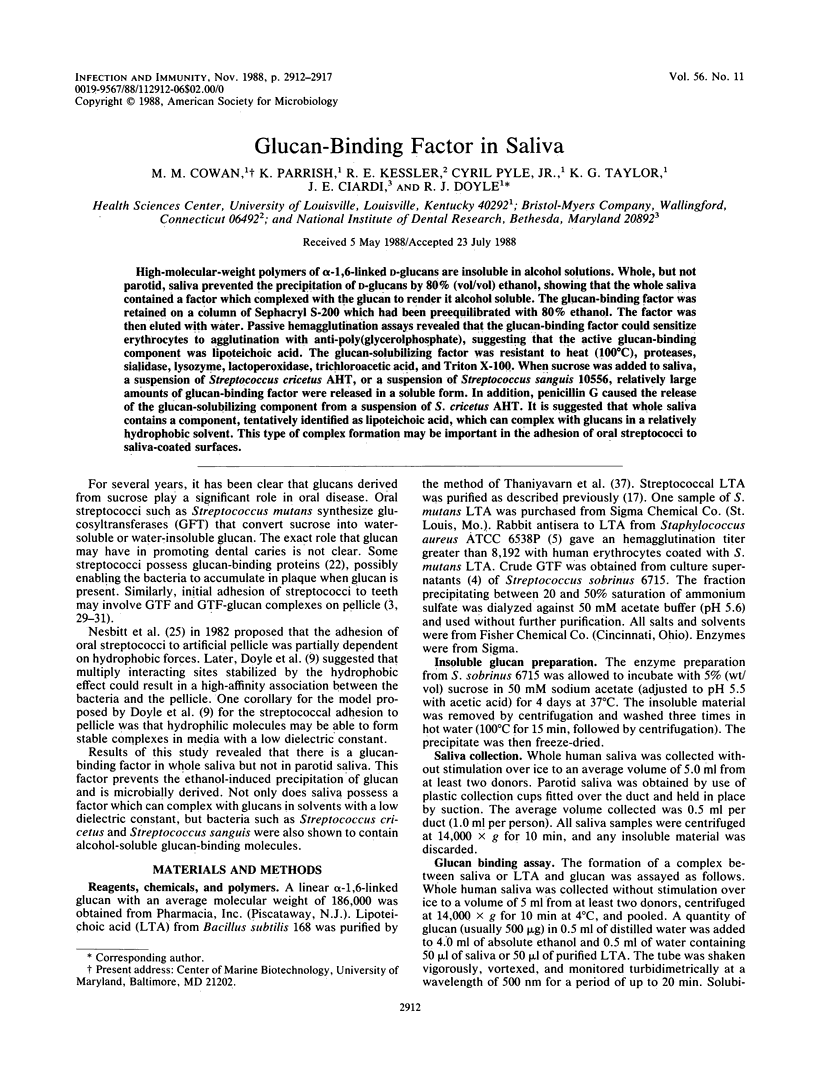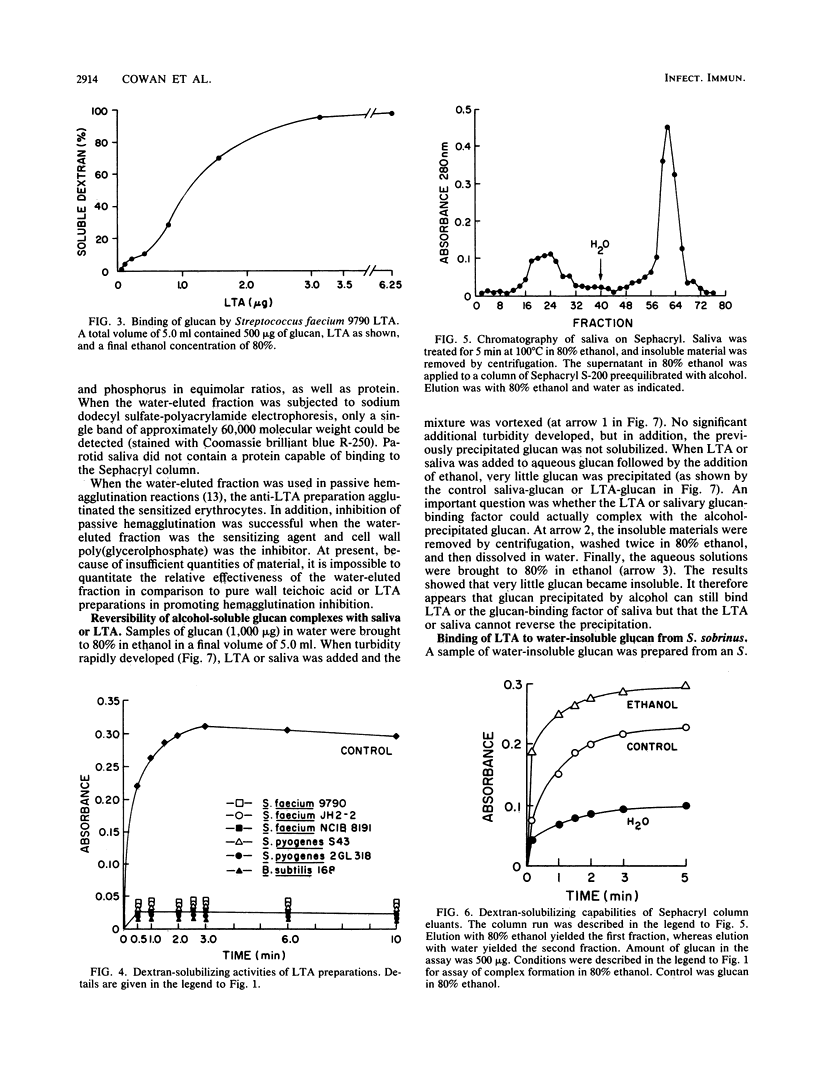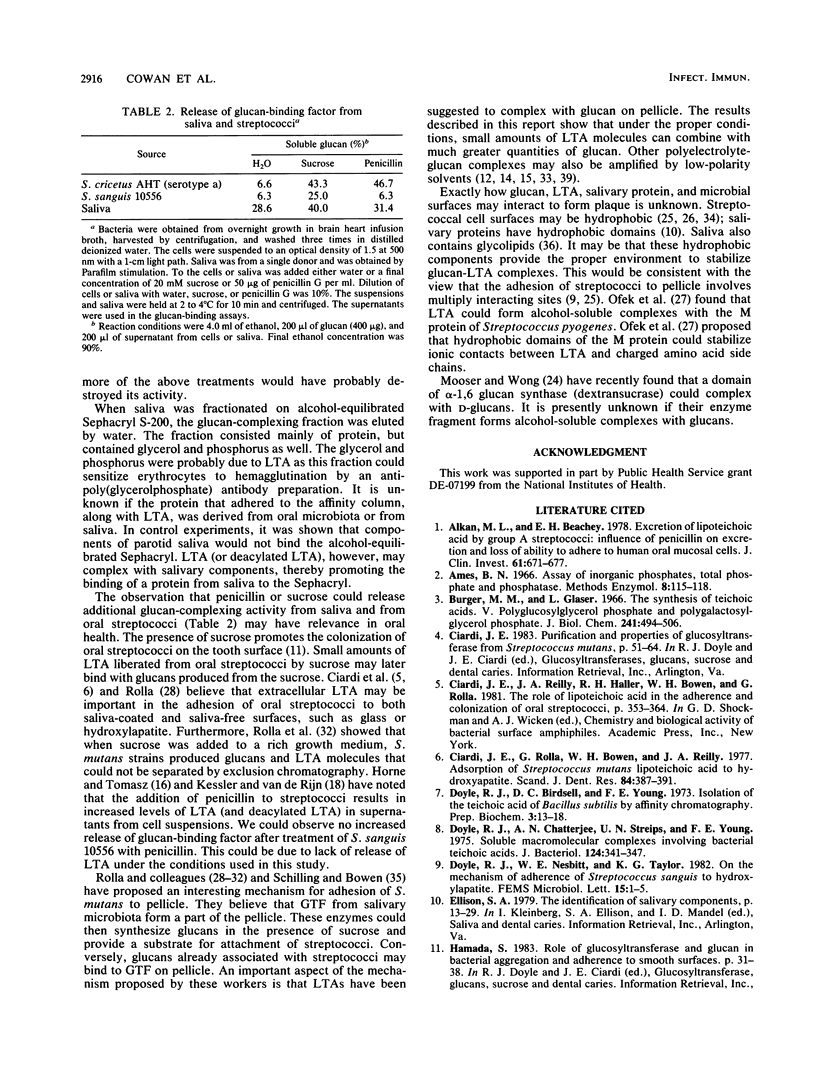Abstract
High-molecular-weight polymers of alpha-1,6-linked D-glucans are insoluble in alcohol solutions. Whole, but not parotid, saliva prevented the precipitation of D-glucans by 80% (vol/vol) ethanol, showing that the whole saliva contained a factor which complexed with the glucan to render it alcohol soluble. The glucan-binding factor was retained on a column of Sephacryl S-200 which had been preequilibrated with 80% ethanol. The factor was then eluted with water. Passive hemagglutination assays revealed that the glucan-binding factor could sensitize erythrocytes to agglutination with anti-poly(glycerolphosphate), suggesting that the active glucan-binding component with lipoteichoic acid. The glucan-solubilizing factor was resistant to heat (100 degrees C), proteases, sialidase, lysozyme, lactoperoxidase, trichloroacetic acid, and Triton X-100. When sucrose was added to saliva, a suspension of Streptococcus cricetus AHT, or a suspension of Streptococcus sanguis 10556, relatively large amounts of glucan-binding factor were released in a soluble form. In addition, penicillin G caused the release of the glucan-solubilizing component from a suspension of S. cricetus AHT. It is suggested that whole saliva contains a component, tentatively identified as lipoteichoic acid, which can complex with glucans in a relatively hydrophobic solvent. This type of complex formation may be important in the adhesion of oral streptococci to saliva-coated surfaces.
Full text
PDF





Selected References
These references are in PubMed. This may not be the complete list of references from this article.
- Alkan M. L., Beachey E. H. Excretion of lipoteichoic acid by group A streptococci. Influence of penicillin on excretion and loss of ability to adhere to human oral mucosal cells. J Clin Invest. 1978 Mar;61(3):671–677. doi: 10.1172/JCI108979. [DOI] [PMC free article] [PubMed] [Google Scholar]
- Burger M. M., Glaser L. The synthesis of teichoic acids. V. Polyglucosylglycerol phosphate and polygalactosylglycerol phosphate. J Biol Chem. 1966 Jan 25;241(2):494–506. [PubMed] [Google Scholar]
- Ciardi J. E., Rölla G., Bowen W. H., Reilly J. A. Adsorption of Streptococcus mutans lipoteichoic acid to hydroxyapatite. Scand J Dent Res. 1977 Sep;85(6):387–391. doi: 10.1111/j.1600-0722.1977.tb00570.x. [DOI] [PubMed] [Google Scholar]
- Doyle R. J., Birdsell D. C., Young F. E. Isolation of the teichoic acid of Bacillus subtilis 168 by affinity chromatography. Prep Biochem. 1973;3(1):13–18. doi: 10.1080/00327487308061485. [DOI] [PubMed] [Google Scholar]
- Doyle R. J., Chatterjee A. N., Streips U. N., Young F. E. Soluble macromolecular complexes involving bacterial teichoic acids. J Bacteriol. 1975 Oct;124(1):341–347. doi: 10.1128/jb.124.1.341-347.1975. [DOI] [PMC free article] [PubMed] [Google Scholar]
- Hewett M. J., Knox K. W., Wicken A. J. Studies on the group F antigen of lactobacilli: detection of antibodies by haemagglutination. J Gen Microbiol. 1970 Mar;60(3):315–322. doi: 10.1099/00221287-60-3-315. [DOI] [PubMed] [Google Scholar]
- Hogg S. D., Embery G. Blood-group-reactive glycoprotein from human saliva interacts with lipoteichoic acid on the surface of Streptococcus sanguis cells. Arch Oral Biol. 1982;27(3):261–268. doi: 10.1016/0003-9969(82)90060-7. [DOI] [PubMed] [Google Scholar]
- Hogg S. D., Handley P. S., Embery G. Surface fibrils may be responsible for the salivary glycoprotein-mediated aggregation of the oral bacterium Streptococcus sanguis. Arch Oral Biol. 1981;26(11):945–949. doi: 10.1016/0003-9969(81)90156-4. [DOI] [PubMed] [Google Scholar]
- Horne D., Tomasz A. Release of lipoteichoic acid from Streptococcus sanguis: stimulation of release during penicillin treatment. J Bacteriol. 1979 Mar;137(3):1180–1184. doi: 10.1128/jb.137.3.1180-1184.1979. [DOI] [PMC free article] [PubMed] [Google Scholar]
- Kessler R. E., Thivierge B. H. Effects of substitution on polyglycerol phosphate-specific antibody binding to lipoteichoic acids. Infect Immun. 1983 Aug;41(2):549–555. doi: 10.1128/iai.41.2.549-555.1983. [DOI] [PMC free article] [PubMed] [Google Scholar]
- Kessler R. E., van de Rijn I. Effects of penicillin on group A streptococci: loss of viability appears to precede stimulation of release of lipoteichoic acid. Antimicrob Agents Chemother. 1981 Jan;19(1):39–43. doi: 10.1128/aac.19.1.39. [DOI] [PMC free article] [PubMed] [Google Scholar]
- Kessler R. E., van de Rijn I., McCarty M. Characterization and localization of the enzymatic deacylation of lipoteichoic acid in group A streptococci. J Exp Med. 1979 Dec 1;150(6):1498–1509. doi: 10.1084/jem.150.6.1498. [DOI] [PMC free article] [PubMed] [Google Scholar]
- LOWRY O. H., ROSEBROUGH N. J., FARR A. L., RANDALL R. J. Protein measurement with the Folin phenol reagent. J Biol Chem. 1951 Nov;193(1):265–275. [PubMed] [Google Scholar]
- MOKRASCH L. C. Analysis of hexose phosphates and sugar mixtures with the anthrone reagent. J Biol Chem. 1954 May;208(1):55–59. [PubMed] [Google Scholar]
- Mattingly S. J., Johnston B. P. Comparative analysis of the localization of lipoteichoic acid in Streptococcus agalactiae and Streptococcus pyogenes. Infect Immun. 1987 Oct;55(10):2383–2386. doi: 10.1128/iai.55.10.2383-2386.1987. [DOI] [PMC free article] [PubMed] [Google Scholar]
- McCabe M. M., Smith E. E. Relationship between cell-bound dextransucrase and the agglutination of Streptococcus mutans. Infect Immun. 1975 Sep;12(3):512–520. doi: 10.1128/iai.12.3.512-520.1975. [DOI] [PMC free article] [PubMed] [Google Scholar]
- Mooser G., Wong C. Isolation of a glucan-binding domain of glucosyltransferase (1,6-alpha-glucan synthase) from Streptococcus sobrinus. Infect Immun. 1988 Apr;56(4):880–884. doi: 10.1128/iai.56.4.880-884.1988. [DOI] [PMC free article] [PubMed] [Google Scholar]
- Nesbitt W. E., Doyle R. J., Taylor K. G. Hydrophobic interactions and the adherence of Streptococcus sanguis to hydroxylapatite. Infect Immun. 1982 Nov;38(2):637–644. doi: 10.1128/iai.38.2.637-644.1982. [DOI] [PMC free article] [PubMed] [Google Scholar]
- Nesbitt W. E., Doyle R. J., Taylor K. G., Staat R. H., Arnold R. R. Positive coooperativity in the binding of Streptococcus sanguis to hydroxylapatite. Infect Immun. 1982 Jan;35(1):157–165. doi: 10.1128/iai.35.1.157-165.1982. [DOI] [PMC free article] [PubMed] [Google Scholar]
- Ofek I., Simpson W. A., Beachey E. H. Formation of molecular complexes between a structurally defined M protein and acylated or deacylated lipoteichoic acid of Streptococcus pyogenes. J Bacteriol. 1982 Feb;149(2):426–433. doi: 10.1128/jb.149.2.426-433.1982. [DOI] [PMC free article] [PubMed] [Google Scholar]
- Rolla G., Ciardi J. E., Schultz S. A. Adsorption of glucosyltransferase to saliva coated hydroxyapatite. Possible mechanism for sucrose dependent bacterial colonization of teeth. Scand J Dent Res. 1983 Apr;91(2):112–117. doi: 10.1111/j.1600-0722.1983.tb00786.x. [DOI] [PubMed] [Google Scholar]
- Rosan B. Absence of glycerol teichoic acids in certain oral streptococci. Science. 1978 Sep 8;201(4359):918–920. doi: 10.1126/science.684416. [DOI] [PubMed] [Google Scholar]
- Rølla G., Oppermann R. V., Bowen W. H., Ciardi J. E., Knox K. W. High amounts of lipoteichoic acid in sucrose-induced plaque in vivo. Caries Res. 1980;14(4):235–238. doi: 10.1159/000260459. [DOI] [PubMed] [Google Scholar]
- Schilling K. M., Bowen W. H. The activity of glucosyltransferase adsorbed onto saliva-coated hydroxyapatite. J Dent Res. 1988 Jan;67(1):2–8. doi: 10.1177/00220345880670010201. [DOI] [PubMed] [Google Scholar]
- Slomiany B. L., Witas H., Murty V. L., Slomiany A., Mandel I. D. Association of lipids with proteins and glycoproteins in human saliva. J Dent Res. 1983 Jan;62(1):24–27. doi: 10.1177/00220345830620010601. [DOI] [PubMed] [Google Scholar]
- Van Handel E. Determination of fructose and fructose-yielding carbohydrates with cold anthrone. Anal Biochem. 1967 Apr;19(1):193–194. doi: 10.1016/0003-2697(67)90152-2. [DOI] [PubMed] [Google Scholar]
- Yamamoto T., Koga T., Mizuno J., Hamada S. Chemical and immunological characterization of a novel amphipathic antigen from biotype B Streptococcus sanguis. J Gen Microbiol. 1985 Aug;131(8):1981–1988. doi: 10.1099/00221287-131-8-1981. [DOI] [PubMed] [Google Scholar]


